

Watch Japanese Children Design New Life Forms. New "bionic plants" could replace street lights and cell towers. Honeybees reveal that evolution is stranger than you ever realized. The Unique Merger That Made You (and Ewe, and Yew) - Issue 10: Mergers & Acquisitions. At first glance, a tree could not be more different from the caterpillars that eat its leaves, the mushrooms sprouting from its bark, the grass growing by its trunk, or the humans canoodling under its shade.
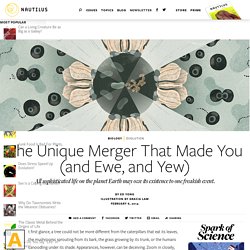
Appearances, however, can be deceiving. Zoom in closely, and you will see that these organisms are all surprisingly similar at a microscopic level. Specifically, they all consist of cells that share the same basic architecture. The most important moment in the evolution of life. 12 of the most astounding 'living fossils' known to science. Why tropical forests have more tree species than US and Canada combined. One hectare of land in a tropical forest can hold 650 tree species—more than is found in all of Canada and the continental US.

This has left biologists baffled for decades. Now, with advances in data analysis, Phyllis Coley and Thomas Kursar of the University of Utah may have finally found an explanation for how so many species can coexist in a relatively small area. From a broad perspective, evolution of this sort of diversity is pretty simple. Successful species survive and reproduce depending on how readily they obtain resources. If two species are too similar in their use of resources, they would compete with each other—unless one evolves to use a different resource and exploits a niche that hasn’t been filled. The competition for niches is shaped by species’ interactions with the environment, which includes both abiotic elements (climate, water, soil, and such) and biotic elements (in other words, other species).
The Red Queen Hypothesis is not new. Selfish gene solves DNA replication puzzle. You were formed from a single cell.
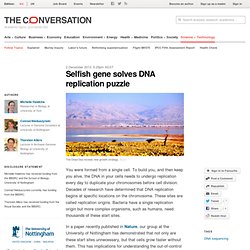
To build you, and then keep you alive, the DNA in your cells needs to undergo replication every day to duplicate your chromosomes before cell division. Decades of research have determined that DNA replication begins at specific locations on the chromosome. Déclin de la biodiversité et répercussion sur les petits écosystèmes. Bien que globalement, on observe un déclin de la biodiversité végétale, Mark Vellend démontre qu'à l'échelle où les plantes interagissent entre elles, ce n'est pas le cas.

High schooler discovers fossil of juvenile dinosaur. As our collection of fossils left by non-avian dinosaurs has grown, we've learned that they were impressive in ways that went beyond sheer size.

Over millions of years of evolution, the animals also achieved incredible diversity in form, with horns, plates, feathers, and other elaborations. One of the strangest forms appeared in the hadrosaurids, more commonly known as the duck-billed dinosaurs. Many of these species had enormous extensions on the peaks of their skulls, formed by elaborating their nasal passages. While we're still not sure exactly what the purpose of these features are—ideas range from display to generating loud calls to breathing in a watery environment—we're a bit more sure about how they developed. That's because a high school student came across a fossil skeleton in southern Utah that provides a glimpse of a juvenile of the species.
The authors of the paper describe the species in question, Parasaurolophus, as "tube crested. " Les abeilles se sont déjà éteintes, en même temps que les dinosaures. Why are apes more genetically diverse than we are? Humans, bonobos, and chimpanzees are genetically quite similar; the DNA sequences we share are almost 98 percent identical.
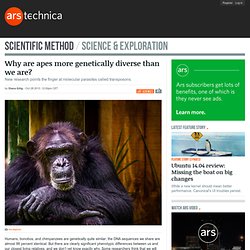
But there are clearly significant phenotypic differences between us and our closest living relatives, and we don’t yet know exactly why. Some researchers think that we will never find out if we continue looking at the DNA of cells that have been preserved. So the researchers generated induced pluripotent stem cells (iPSCs) from chimps and bonobos as tools to study their development and evolution, and how it differs from ours. Results are reported in Nature. Embryonic stem (ES) cells were isolated from rhesus monkeys and marmosets in 1995, and the first human ES cells were isolated in 1998. Once the scientists made the cells, their first order of business was to identify genes that show different patterns of activity in us and the apes. Retrotransposons, like L1, need to first be transcribed into RNA and then copied back into DNA in order to move around. Chemists find biological complexes that beat chance. How life originated from an inanimate set of chemicals is still a mystery.
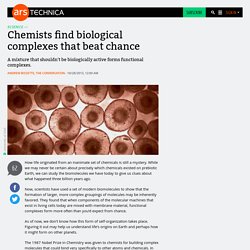
While we may never be certain about precisely which chemicals existed on prebiotic Earth, we can study the biomolecules we have today to give us clues about what happened three billion years ago. Now, scientists have used a set of modern biomolecules to show that the formation of larger, more complex groupings of molecules may be inherently favored. They found that when components of the molecular machines that exist in living cells today are mixed with membrane material, functional complexes form more often than you’d expect from chance. As of now, we don’t know how this form of self-organization takes place. Quest for self-replicating RNA edges closer to life’s possible origin.
The discovery of nucleic acid molecules that can catalyze chemical reactions has revolutionized thinking about the origin of life.
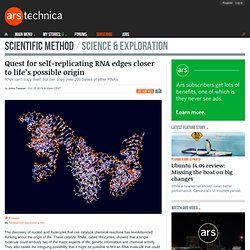
These catalytic RNAs, called ribozymes, showed that a single molecule could embody two of the major aspects of life: genetic information and chemical activity. They also raised the intriguing possibility that it might be possible to find an RNA molecule that could copy itself. After all, once you have a single self-duplicating molecule, you would quickly end up with a large collection of self-duplicating molecules competing for resources. Evolution would be off and running. So far, though, efforts to make a self-replicating ribozyme have come up short. The path to a potential self-replicating RNA has, so far at least, been a bit convoluted.
The Cambridge researchers behind the new paper noticed something unusual. If the ribozyme worked well on ice as-is, the authors reasoned that it would work even better with a chance to adapt to the cold environment. IB - Integrative Biology at The University of Texas at Austin. A Story of Co-Evolution. No Nobel, but epigenetics finally gets the recognition it deserves.
Adrian Bird, Howard Cedar and Aharon Razin were hotly tipped to win this year’s Nobel Prize for Medicine for their pioneering work in the field of epigenetics.
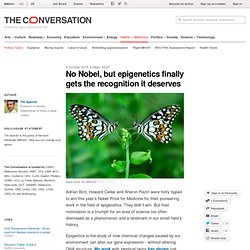
They didn’t win. But their nomination is a triumph for an area of science too often dismissed as a phenomenon and a landmark in our small field’s history. Epigentics is the study of how chemical changes caused by our environment can alter our gene expression - without altering DNA structure. My work with identical twins has shown just how different people with the same genes and the same upbringing can turn out to be and how we may not be as hard-wired as we like to think.
But even since the time of 18th century French naturalist Lamarck, epigenetics has been continually in the shadow of Darwin and its much bigger brother: genetics. Microbe used to improve biofuel production. (Phys.org)—Biofuel production can be an expensive process that requires considerable use of fossil fuels, but a Missouri University of Science and Technology microbiologist's patented process could reduce the cost and the reliance on fossil fuels, while streamlining the process.
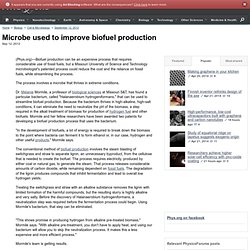
The process involves a microbe that thrives in extreme conditions. Dr. Melanie Mormile, a professor of biological sciences at Missouri S&T, has found a particular bacterium, called "Halanaerobium hydrogeniformans," that can be used to streamline biofuel production. Because the bacterium thrives in high-alkaline, high-salt conditions, it can eliminate the need to neutralize the pH of the biomass, a step required in the alkali treatment of biomass for production of hydrogen fuel and other biofuels.
Mormile and her fellow researchers have been awarded two patents for developing a biofuel production process that uses the bacterium. Bonnie Bassler sur la manière de communiquer des bactéries. Mouseunculus: How The Brain Draws A Little You. Inside each of us is a miniature version of ourselves. The Canadian neurologist Wilder Penfield discovered this little person in the 1930s, when he opened up the skulls of his patients to perform brain surgery. He would sometimes apply a little electric jolt to different spots on the surface of the brain and ask his patients–still conscious–to tell him if they felt anything.
Sometimes their tongues tingled. Emiliania huxleyi: le secret de l'algue qui s'adapte à tout. Gut bacteria may be key to crop pest’s resurgence. For the most part, crop rotation—planting different produce in different years—is advertised as a way of helping the soil by keeping a single crop from draining it of some types of nutrients. But it turns out that crop rotation can also help control some agricultural pests. Many pests are specialized feeders that grow on a limited number of plants. Place a distantly related species in the same field, and the pests find themselves with nothing to eat.
By the time the original crop rotates back into the field, the bugs that specialize in feeding on it are long since dead. This approach helped effectively control the western corn rootworm. How does an insect become resistant to the fact that its normal meal vanishes? The corn rootworm life cycle is pretty simple. So what's up with the resistant strain? Birds and the feather did not evolve together. “Which came first, the chicken or the egg?” Evolutionarily speaking, it’s a yawn of a conundrum. We know it was the egg, which evolved (with shell to enable a terrestrial lifestyle) some 300 million years ago, long before a chicken first clucked across a patch of open ground.
In between the origin of the egg and the domestication of the chicken, however, there are plenty of other interesting features to consider. Gut bacteria may be key to crop pest’s resurgence. Researchers find a completely new DNA binding protein. The basic premises underlying gene expression—when and where genes are turned on and off—were worked out in bacteria by François Jacob and Jacques Monod in the middle of the twentieth century. The expression of a gene typically relies on one or more proteins binding to a specific DNA sequence near the gene of interest. These proteins are called transcription factors since they regulate the transcription of genes into RNA, the first step in turning them into proteins.
How did feathers evolve? - Carl Zimmer. Origin of life researchers figure out how to build bigger RNAs. We'll probably never know exactly how life on Earth got its start. The conditions in which it began have long since been lost, and there are simply too many precursor molecules and potential environments that could have gotten the process going. Nevertheless, researchers hope to put together a pathway that's at least plausible, starting from simple molecules that were present on the early Earth and building up to an enclosed system with basic inheritance (from there, evolution can take over). How To Make Antivenom. Cataloging the controlled chaos of the human genome. The completion of the human genome, rather than being the huge breakthrough it was presented as, raised almost as many questions as it answered.
Carnivorous plant has deleted most of its junk DNA. Over the weekend, Nature released a paper that describes the genome of a fascinating creature with a rather unglamorous name: the bladderwort. These plants live in swampy or liquid environments and find it hard to get sufficient nutrients there, so the plants have turned carnivorous in order to survive.
The bladders that give the group of related species its name are actually feeding organs. When an organism brushes up against their triggers, the bladders swell by sucking in the surrounding water, along with any organisms it carries. They then seal off, allowing the plant to digest its prey. NERC - Plants use underground networks to warn of enemy attack. Fungus Is The Internet Of The Plant World. Fungus. Even the word itself feels like fungus. Fungus network 'plays role in plant communication' 10 May 2013Last updated at 03:10 ET Mycorrhizae are mutualistic - they both need and are needed by the plants whose roots they inhabit. Mapping the Human Brain. Early Results of Three-Year Monitoring of Red Wood Ants’ Behavioral Changes and Their Possible Correlation with Earthquake Events.
Open AccessThis article isfreely availablere-usable. Neurodiversity Rewires Conventional Thinking About Brains. Understanding the brain of a man with no conscious memory. See-through brains clarify connections. Expérience de Miller-Urey. Synthetic double-helix faithfully stores Shakespeare's sonnets. The Most Amazing Thing About Trees. Dogs vs. Hyenas? Chew on this! Why the mantis shrimp is my new favorite animal. Poor, cute bunnies likely to get eaten when the snow melts early. Interactive map plots locations of more than 100 million species. Biodiversity Information Serving Our Nation (BISON) BioMotionLab. Enzymes turn inedible waste plant material into food and fuel. Origin of life researchers figure out how to build bigger RNAs. Rapid Changes in Tree Leaf Chemistry Induced by Damage: Evidence for Communication Between Plants.
Les plantes disposent-elles d’une forme d’« intelligence » ? New Species of Bizarre Deep Sea Jellyfish Spotted! Speciation: Of Ligers & Men - Crash Course Biology #15. Animal Magnetism: How Animals Navigate. Dennis Charney: Neuroplasticity and Your Resilient Brain. Chemical biology: DNA's new alphabet. Sperm Trajectories, Evolving Humans and a Tomato Tapestry: The Best Scientific Figures of 2012. Le cerveau catégorise les choses que nous voyons.
Medecine. Cycle de Calvin. L'étonnante stabilité de notre flore bactérienne. Ces petites pyramides sont des cages microscopiques pour les cellules. De l'art bactériologique. Giant Eyeball Found on the Beach. Bioengineered Soccer Ball Grown From Pig Cells. Artificial cells evolve proteins to structure semiconductors. Ce gros truc dégueu est la clé de notre futur... peut-être.
Human Microbiome Project DACC - Home. GenBank Home. Horse respiratory tract in 3D. Rewritable memory encoded into DNA. Scientists Invent Oxygen Particle That If Injected, Allows You To Live Without Breathing. Un spray nasal pour éviter les suicides ? Une nouvelle vision du génome bouleverse la biologie. Origine de la vie. 04/05 > BE Israël 77 > Une fonction "TAUtalement" nouvelle.
04/05 > BE Israël 77 > Des "horlogers" moléculaires à l'institut Weizmann. 04/05 > BE Israël 77 > Dissection des mécanismes de libération synaptique. 04/05 > BE Israël 77 > Une collaboration internationale permet de décrire un mécanisme ON/OFF impliqué dans la réponse au stress. 04/05 > BE Israël 77 > Découverte d'un gène qui augmente l'espérance de vie de la souris.
04/05 > BE Israël 77 > Des chercheurs de l'Institut Weizmann découvrent comment une cellule se prépare aux périodes de famine. 04/05 > BE Israël 77 > L'hormone de l'amour. 04/04 > BE Italie 102 > L'intelligence des moisissures ouvre de nouvelles voies pour internet. Des poissons pour comprendre les émotions. Accueil equipe de Laure Bailly-Cruif. Projets scientifiques. 04/19 > BE Espagne 114 > Des bactéries pour transformer l'énergie chimique des résidus en énergie électrique. 04/19 > BE France 269 > 5 millions d'euros pour Enterome et sa technologie unique de métagénomique bactérienne.
05/09 > BE Belgique 61 > Comment la transcription des gènes participe à la diversité protéique. Explore the Human Microbiome [Interactive] 05/23 > BE Canada 405 > Une étude apporte le chaînon manquant de la théorie de vie sans oxygène de Louis Pasteur. L’ADN transformé en mémoire réinscriptible. Des étudiants révolutionnent l'ADN ! LE TARDIGRADE UN VOYAGEUR DE L'ESPACE ? 06/11 > BE Belgique 62 > La bio informatique au secours de la génétique. Vidéos de la séance publique "Les réactions de défense des insectes : un modèle d'étude de l'immunité innée" de Jules Hoffmann - Les défis scientifiques du 21e siècle du 29 mai 2012. Vidéos de la séance publique "Les grandes avancées françaises en biologie présentées par leurs auteurs" du 5 juin 2012. 06/06 > BE Allemagne 574 > La croissance des plantes en voie d'être pleinement comprise. Je Like - The Map of Life: les archives de Dame Nature...